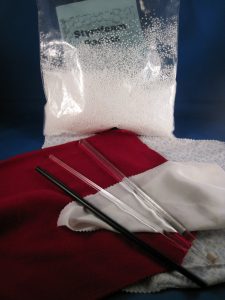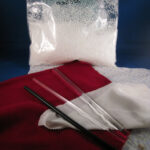Charged Picker Upper

Author(s): Seth Bush
Subject: Physics
Grade Level(s): Grade 4
Big Idea(s):
- Students know electrically charged objects attract or repel each other.
- Students know charged particles are sources of electric fields and are subject to the forces of the electric fields from other charges.
- Students know static electric fields have as their source some arrangement of electric charges.
What you need:
• Balloon
• Charging equipment (plastic rods, glass rods, pelts, silk, wool or similar)
• Bits of paper, foil, pith, pepper, etc (small neutral objects)
• Aluminum Can
• Ping Pong Ball
• Ruler
Setting: Classroom
Time Needed: Teacher’s Discretion
Summary:
In this activity we will use a charged rod or balloon to pick up small neutral objects and move large neutral objects. We will use our observations to develop the concept of induction.
Learning Goals / Objectives:
1.) Students will learn that there are two types of charge: negative and positive.
2.) Students will learn that:
• a neutral object is charge balanced. It has – the same number of electrons (negative charge carrier) as protons (positive charge carrier)
• a negatively charged object has extra electrons
• a positively charged object has some electrons removed
3.) Students will observe how charged objects interact with neutral objects.
4.) Students will be introduced to the concept of induction, an “induced charge” and an electric dipole.
Background
This activity, like all electrostatic activities that rely on building up and maintaining a charge, can be a bit temperamental. It will work best on a dry day with very low humidity.
Safety
This activity has little to no risk associated with it. Use common sense.
Setup:
Work in groups of two.
Anticipatory Set:
Driving Questions
1.) How do charged things interact with:
• Other charged things?
• Neutral things?
2.) What does rubbing have to do with charge?
3.) Why are neutral things attracted to charged things?
Instructions / Activities:
Part A: Tape
1.) Test your tape strips from Sticky Charge Detector using your charging wand.
a. With each rod before charging.
b. With a glass rod charged with wool; with silk.
c. With a black rubber rod charged with wool; with silk.
d. With a plastic rod charged with wool; with silk.
2.) Record your observations in a table in your notebook.
3.) Can you infer the charges on the rods and tape from your observations?
Part B: Small Bits
1.) Distribute small bits of material (scraps of paper, crushed pepper etc) on your desktop.
2.) Pass an uncharged rod (or balloon) over the bits of material.
3.) Record your observations in your notebook.
4.) Redistribute the small bits of material on your desktop.
5.) Charge a rod by rubbing it with either a pelt or a piece of material. If you are using a
balloon, charge your balloon using either your hair or a sweater.
6.) Pass a charged rod (or balloon) over the bits of material.
7.) Record your observations.
Optional: Get Quantitative.
Measure the distance when charged rod begins to interact with either object.
Follow up questions:
1.) Can you explain your observations?
2.) Imagine the rod has a net positive charge and the bits of material are neutral. The
cartoon (to right) depicts the charge distribution in the rod and in the bit of material before they are brought near each other. How might these distributions look when the objects are brought near each other? Sketch the new charge distribution.
Part C: Big Bits
1.) Place a ping-pong ball and an aluminum can on your desktop.
2.) Move an uncharged rod (or balloon) close to each of the objects.
3.) Record your observations in your notebook.
4.) Place the ping-pong ball and aluminum can on your desktop.
5.) Charge a rod by rubbing it with either a pelt or a piece of material. If you are using a
balloon, charge your balloon using either your hair or a sweater.
6.) Move a charged rod (or balloon) close to each of the objects.
7.) Record your observations in your notebook.
Optional: Get Quantitative.
Measure the distance when charged rod begins to interact with either object.
Follow up questions:
1.) Can you explain your observations?
2.) Aluminum is a conductor. Conductors allow electrons to move freely. Plastic is an insulator.Insulators do not allow electrons to move freely. If identical neutral objects are made of plastic and aluminum, which object will be most affected by the presence of a charged rod? Explain.
Assessment:
Teacher’s Discretion
Wrap-up / Closure:
Thought questions:
1.) In a normal room, any given volume is neutral because it has roughly the same number of positive charges (protons) as negative charges (electrons). Imagine all the electrons in a normal room moved to one side of the room (see cartoon below).
a. Would the room still be neutral?
b. Which end of the room (if either) would attract a positively charged balloon?
Practical Application Extension question:
1.) How does the idea of static charge apply to a device like “Ionic Breeze” , “Swiffer Broom” or Dryer Sheets?
These materials are contained in a kit in our Library!


